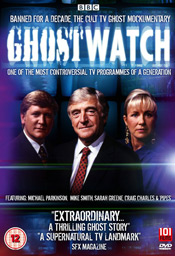20th Anniversary for Ghostwatch parody spook show that sparked a new TV genre
 This year represents the twentieth anniversary of the BBC faux-documentary Ghostwatch. The 90 minute drama, which first aired on 31st October 1992, caused a media storm and record numbers of calls to the BBC switchboard due to the frightening nature of the scenes and concern for the welfare of the presenter Sarah Greene, who appeared to be dragged behind a doorway to her apparent demise. University of Warwick researchers say that while it may no longer frighten after 20 years it has spawned a new genre of spectral reality TV.
This year represents the twentieth anniversary of the BBC faux-documentary Ghostwatch. The 90 minute drama, which first aired on 31st October 1992, caused a media storm and record numbers of calls to the BBC switchboard due to the frightening nature of the scenes and concern for the welfare of the presenter Sarah Greene, who appeared to be dragged behind a doorway to her apparent demise. University of Warwick researchers say that while it may no longer frighten after 20 years it has spawned a new genre of spectral reality TV.
The fallout was for the BBC to impose censorship in the form of a decade long ban on broadcasting the film, but the legacy of Ghostwatch lives on. The story of the malevolent ghost, Pipes, has had a significant impact on film and television since its release.
Tom Steward, Lecturer in Television Studies at the University of Warwick explained the influence of the drama on horror genres and beyond: “Ghostwatch has been credited with launching a new wave of horror films, from The Blair Witch Project to the soon-to-be-released VHS, which used direct-to-camera address and hand-held video footage to scare the audience. Contemporary filmmakers and TV dramatists continue to use television as a horror device, with Charlie Brooker’s 2007 Halloween zombie miniseries Dead Set taking place in the Big Brother house and supernatural threats coming from TV sets in films such as The Ring. The programme ultimately disturbed so many people because it prickled cultural anxieties about television as a corrupting influence on society.
“Looking back at the programme you’d be forgiven for thinking that Ghostwatch was a parody of ‘ghost hunting’ reality programmes like LivingTV’s Most Haunted: Live but in fact the programme predates the genre by a decade. It’s one of those rare instances in TV of the spoof pre-empting the original and actually setting a precedent for a new type of programme.”
But is Ghostwatch still as impactful and terrifying as it was twenty years ago? Tom adds: “Ghostwatch stands up very well as a satire on television. As viewers become more literate in and conscious of TV conventions, they can see more clearly how it works as a spot-on parody of live factual programmes. However, being able to laugh along with it has the potential to make it a lot less scary. When I showed a scene of Ghostwatch to my students in which the poltergeist invades Television Centre, most of them were amused at how presenter Michael Parkinson continued addressing the viewer, rather than chilled at the thought of a ghost in every home across the nation.
“Thanks to programmes like Brass Eye, The Daily Show and The Office, viewers are now used to TV regularly sending itself up, but in 1992 this was unknown territory for TV audiences. To some extent, this naivety probably accounts for why many viewers at the time apparently believed it really was a factual programme and felt outraged at having being victims of a hoax.”
About Ghostwatch
Ghostwatch was written by Stephen Volk as part of BBC’s Screen One drama series. It was directed by Lesley Manning and produced by Richard Broke, Ruth Baumgarten and Derek Nelson. The film starred Michael Parkinson, Craig Charles, Sarah Greene and Mike Smith. In 2002, the British Film Institute released a 10th Anniversary edition on VHS and DVD.
Contact Details
To contact Tom Steward; m: +44 (0)7791 742301
For further information or to arrange interviews with University of Warwick contact Luke Harrison, Communications Manager on +44 (0)2476 574255/150483, m: +44(0)7792 051739 or luke.harrison@warwick.ac.uk
